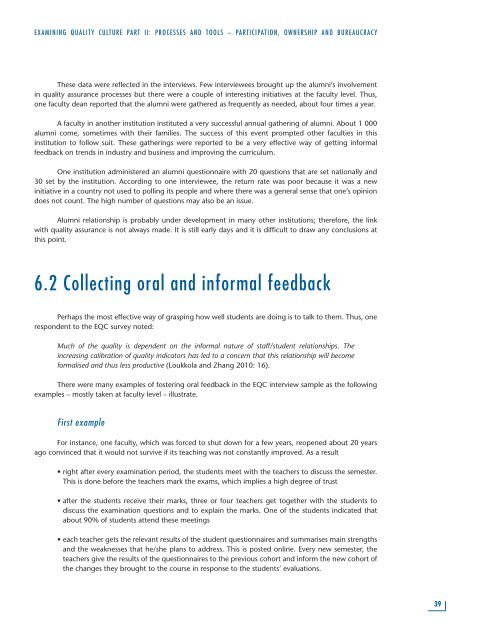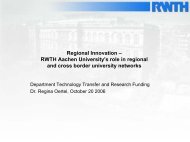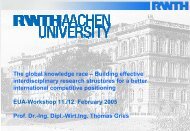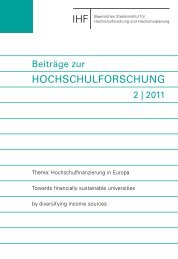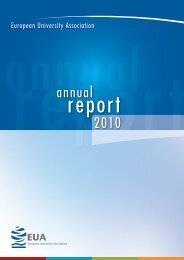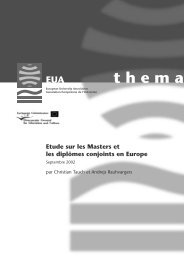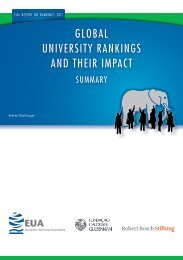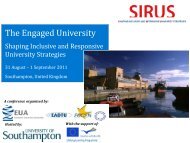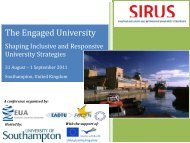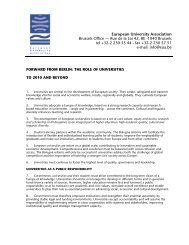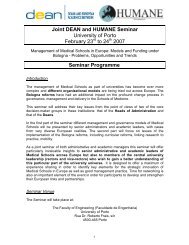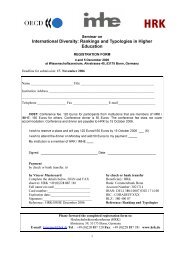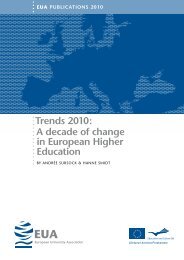Examining Quality Culture Part II: - European University Association
Examining Quality Culture Part II: - European University Association
Examining Quality Culture Part II: - European University Association
You also want an ePaper? Increase the reach of your titles
YUMPU automatically turns print PDFs into web optimized ePapers that Google loves.
ExAmININg QUALITy CULTUrE PArT <strong>II</strong>: PrOCESSES ANd TOOLS – PArTICIPATION, OwNErShIP ANd BUrEAUCrACy<br />
These data were reflected in the interviews. Few interviewees brought up the alumni’s involvement<br />
in quality assurance processes but there were a couple of interesting initiatives at the faculty level. Thus,<br />
one faculty dean reported that the alumni were gathered as frequently as needed, about four times a year.<br />
A faculty in another institution instituted a very successful annual gathering of alumni. About 1 000<br />
alumni come, sometimes with their families. The success of this event prompted other faculties in this<br />
institution to follow suit. These gatherings were reported to be a very effective way of getting informal<br />
feedback on trends in industry and business and improving the curriculum.<br />
One institution administered an alumni questionnaire with 20 questions that are set nationally and<br />
30 set by the institution. According to one interviewee, the return rate was poor because it was a new<br />
initiative in a country not used to polling its people and where there was a general sense that one’s opinion<br />
does not count. The high number of questions may also be an issue.<br />
Alumni relationship is probably under development in many other institutions; therefore, the link<br />
with quality assurance is not always made. It is still early days and it is difficult to draw any conclusions at<br />
this point.<br />
6.2 Collecting oral and informal feedback<br />
Perhaps the most effective way of grasping how well students are doing is to talk to them. Thus, one<br />
respondent to the EQC survey noted:<br />
Much of the quality is dependent on the informal nature of staff/student relationships. The<br />
increasing calibration of quality indicators has led to a concern that this relationship will become<br />
formalised and thus less productive (Loukkola and Zhang 2010: 16).<br />
There were many examples of fostering oral feedback in the EQC interview sample as the following<br />
examples – mostly taken at faculty level – illustrate.<br />
First example<br />
For instance, one faculty, which was forced to shut down for a few years, reopened about 20 years<br />
ago convinced that it would not survive if its teaching was not constantly improved. As a result<br />
• right after every examination period, the students meet with the teachers to discuss the semester.<br />
This is done before the teachers mark the exams, which implies a high degree of trust<br />
• after the students receive their marks, three or four teachers get together with the students to<br />
discuss the examination questions and to explain the marks. One of the students indicated that<br />
about 90% of students attend these meetings<br />
• each teacher gets the relevant results of the student questionnaires and summarises main strengths<br />
and the weaknesses that he/she plans to address. This is posted online. Every new semester, the<br />
teachers give the results of the questionnaires to the previous cohort and inform the new cohort of<br />
the changes they brought to the course in response to the students’ evaluations.<br />
39


